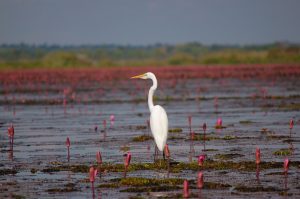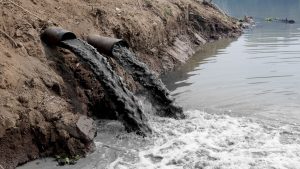 Prof. Dr. P. K. Jena in Bhubaneswar, May 30, 2022: Wetlands consist of marshes, swamps, bogs and similar areas. The functions of wetlands are filtering out of sediments and nutrients from the surface water and support all life forms through extensive food webs and bio-diversity.
Prof. Dr. P. K. Jena in Bhubaneswar, May 30, 2022: Wetlands consist of marshes, swamps, bogs and similar areas. The functions of wetlands are filtering out of sediments and nutrients from the surface water and support all life forms through extensive food webs and bio-diversity.
The wetlands contribute a number of important processes including movement of water into streams and rivers, decay of organic matter, release of sulphur, nitrogen and carbon into atmosphere and growth and development of different types of organisms.
The direct benefits that human beings derive from wetlands include production of fish, timber and fresh water. The indirect benefits include flood control, recharge of aquifer and storm protection. Wetlands have capacity to retain excess flood water during heavy rainfall.
Wetland vegetation helps in control of erosion thus stabilizing the shore line and protecting from storm. These retain nutrients by storing nitrogen and phosphorous and also help in absorbing sewage and purifying water supplies. Thus, wetlands help the mankind in various ways and have a major positive role in maintaining the ecological balance.
Wetlands occupy nearly 6.4% (about 8.6 million sq. km) of the earth surface. Out of which, nearly half are found in the tropics and sub-tropics. About 50% of the World’s wetlands have been lost due to careless human activities like urbanization, drainage for agriculture and water system regulations, also developmental activities like industrialization, excavation, filling, drilling etc.
India has got nearly sixty seven thousands of wetlands covering an area of about 4.1 million hectares. Out of these wetlands, about 2200 are natural and the rest are man made. The country is blessed with numerous rivers and streams by virtue of its geography, varied terrain and climatic conditions. India possesses a rich diversity of inland and coastal wetland habitats. Wetlands in India excluding the rivers account for about 18.4% of the countries geographic area, out of which nearly two-third is under paddy cultivation.
 In India, the major river systems in the north are the rivers Ganga, Yamuna and Brahmaputra, which are perennial originating from the Himalayas. In the southern part of the country, the major river systems include Krishna, Godavari and Cauvery. In the central part of India, the major rivers are Narmada and Tapti and in the eastern part the major rivers are Mahanadi, Brahmani and Baitarani. All these rivers are mainly rain fed.
In India, the major river systems in the north are the rivers Ganga, Yamuna and Brahmaputra, which are perennial originating from the Himalayas. In the southern part of the country, the major river systems include Krishna, Godavari and Cauvery. In the central part of India, the major rivers are Narmada and Tapti and in the eastern part the major rivers are Mahanadi, Brahmani and Baitarani. All these rivers are mainly rain fed.
The Indo-Gangetic flood plain is the largest wetland of India. Most of the natural wetlands of the country are connected with the river systems both in the north and south. The Himalayan Mountain range in the northern part of India possesses a good number of lakes. The north-eastern and eastern part of India posses the massive flood plains of Ganga and Brahmaputra along with a large number of swamps, marshes and lakes.
Besides these natural wetlands, there are a large number of wetlands in the country which are about 2.6 million hectares excluding paddy fields, rivers and streams. Some of the important wetlands include the Beas and the Sutlej in Punjab and Himachal Pradesh, the Koshi barrage in Bihar – Nepal Boarder, Hirakud Dam in Orissa etc.
The mangroves occupy 45 lakh hectares of wetland in the country. About 80% of these are in the Sunderban areas of West Bengal and Andaman & Nicobar Islands and the rest are in the coastal states of Orissa, Andhra Pradesh, Tamilnadu, Karnataka, Kerela, Goa, Maharashtra and Gujarat.
The wetlands of India, have been drained and transformed by anthropogenic activities like unplanned development of urban and industrial sites, agricultural activities, construction of highways, impoundments, resource extraction and dredge disposal causing long term economic and ecological loss.
According to the survey conducted by Wildlife Institute of India, 70 to 80% of fresh water marshes and lakes in the gangetic flood plains have been lost during the last 50 years. As a matter of fact, during the last century, 50% of India’s wetlands have been lost. The mangrove area of the country has been reduced from about 7 lakh hectares in 1987 to 4.53 lakh hectares in 1995.
 About 32% of the wetlands in India have been lost primarily through hunting and associated disturbances, 22% due to human settlements, 19% due to fishing and 23% through drainage from agriculture. Removal of vegetation in the catchment areas leading to soil erosion and siltation, contributes to about 15% loss of wetlands. Pollution from industries contributes to about 20% loss of wetlands.
About 32% of the wetlands in India have been lost primarily through hunting and associated disturbances, 22% due to human settlements, 19% due to fishing and 23% through drainage from agriculture. Removal of vegetation in the catchment areas leading to soil erosion and siltation, contributes to about 15% loss of wetlands. Pollution from industries contributes to about 20% loss of wetlands.
Some of the major human activities as given below are responsible for destruction of wetlands in India
1) Hydrologic Alteration
India’s entire land surface has been altered through long-term human use and manipulations (e.g., intensive cropping, deforestation, intensive grazing and alteration of water flows). Anthropogenic alteration of the hydrological regime has further led to alterations in natural drainage
2) Agricultural Activities
The conversion of wetlands, deltas and flood plains of most rivers in India to paddy fields is rampant, following ‘Green revolution’ of the early 70’s. It is an ecological irony that as a result of this, the gross spatial extent of wetlands in the Indian subcontinent is greater today than it was 3000 years ago owing to increased paddy fields treated as wetlands. For example, the rich Gangetic floodplains, with easy access to water, constitute one of the most intensively cultivated regions of the world. The Kolleru lake in Andhra Pradesh has lost some 34,000 hectares of natural wetlands to agriculture.
 3) Pollution
3) Pollution
More than 50,000 small and large lakes in India are polluted to the point of being considered ‘dead’. The natural coastal wetlands are also polluted to the extent that their fishery and recreational values are almost lost. The prime sources of pollution are domestic and industrial sewage as point source besides agricultural runoff and the more insidious atmospheric pollution contributing to the non-point source pollution.
4) Legal-Policy Failures
Wetlands jurisdiction is diffused and falls under various areas like agriculture, fisheries, irrigation, revenue, tourism, water resources and local bodies. For instance, all mangroves in the country fall under the direct control of forest department. The lack of a comprehensive wetland policy, with each department having its own developmental priorities, works against the interests of conservation of wetlands resulting in intended or unintended ‘spill-over’ further aggravating the problem.
5) Direct Deforestation in Wetlands
Land-uses of farming and fisheries production have replaced many mangrove areas and continue to pose threats to the forests. The loss of wetland forests, coastal or riverine, reduces the ability of wetlands to trap suspended sediments.
6) Inundation by Dammed Reservoirs
The erratic alterations of impounded water levels, the potential for shoreline wetlands to develop and mitigate the losses of river bottom and riparian zones is minimal. As a result of variable dam releases for power generation, the wetted area does not follow a predictable seasonal pattern, precluding development of a stable wetland flora and wildlife community.
7)Degradation of Water Quality
More than 50,000 small and large Indian lakes are polluted to the point of being considered ‘dead’. The primary sources of pollution are human sewage, industrial pollution and agricultural runoff that may contain pesticides, fertilisers and herbicides.
8) Ground-Water Depletion
Water pumping in most parts of India continues to reduce ground-water level by 1.5 to 6 m per year in some areas, and the beds of rivers that once flowed continuously are now found to be dry for many months of the year.
9) Introduced Species – Extinction of Native Biota
Indian wetlands are highly threatened by exotic plant species such as water hyacinth and salvinia.
In view of the above mentioned highly damaging situation, it is very essential to properly manage and develop the wetlands of India, so that these invaluable resources can be properly utilized for our socio economic development and for keeping our environment healthy.
• Former Director General, CSIR



Leave a Reply
Be the First to Comment!